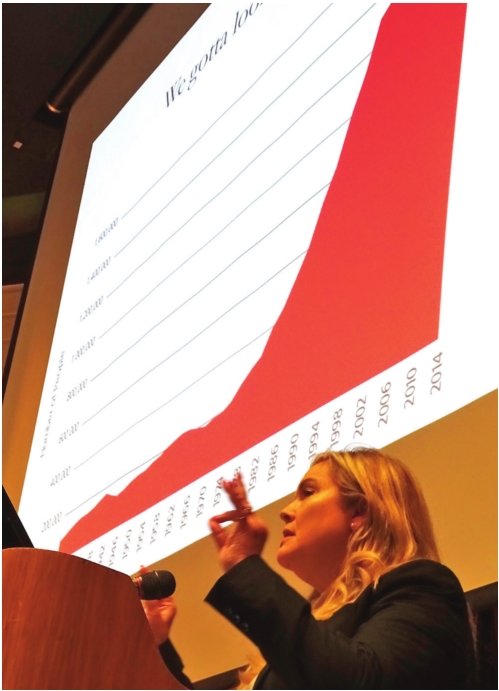
Most folks who grew up in a mostly white suburb have probably gotten an earful over the dinner table about how coddled prisoners are in the United States. A dear, but cruelly misled relative, once told me prisoners were suing the state because they were served crunchy peanut butter instead of creamy.
There is no limit to the delusions people outside of prison continue to cherish about the vast scale of America’s incarcerated population, how wretched conditions are on the inside, and how devastating our nation’s wholesale human warehousing has been for our communities.
“States of Incarceration,” a national traveling exhibit now at the Michigan History Museum, is a rare public window into a vast but hidden landscape.
Developed by the Humanities Action Lab at Rutgers University with the help of hundreds of students and formerly incarcerated people, the exhibit tackles a daunting topic from a dozen angles, from individual stories to reams of shocking social and economic data. There are rare photographs of prison life, furniture made by prisoners and an interactive display that shows you how close you are to falling into the rabbit hole of prison yourself.
Hint: closer than you think. Heather Ann Thompson, one of the scholars who helped to develop “States of Incarceration,” gave a passionate and sobering keynote speech for the exhibit’s opening.
“We have erected the world’s largest criminal justice apparatus — not just prisons, but jails, immigration detention centers, juvenile justice facilities, you name it,” Thompson said.
Thompson, a history professor at the University of Michigan, is the author of the most riveting and superbly researched book about prisons written in the past 20 years, “Blood in the Water: The Attica Prison Uprising of 1971 and its Legacy.” With a combination of granular, minute-to-minute detail and a historian’s perspective, “Attica” took the 2017 Pulitzer Prize in History and a slew of other major awards.
She last delivered a keynote for the traveling “Incarceration” exhibit at the Civil Rights Museum in Greensboro, North Carolina and welcomed the project’s arrival in Michigan.
“Everywhere it goes, each locale adds its own story, Thompson said. “The Michigan piece is really powerful. I grew up in Detroit and live there and I didn’t know some of this stuff until now.”
Mass incarceration, Thompson told the group, has not been driven by crime rates, but rather by political choices, beginning with the “war on crime” of the early 1970s.
“Mass incarceration has a devastating impact on the communities we all hope to nourish and not destroy,” she said.
The resulting damage is like a national hurricane. On the east side of Detroit alone, Thompson said, one in 22 people are in some form of correctional control. In the Brewer Park neighborhood, that’s 1 in 16.
“You’re not going to tell me that white folks don’t like marijuana, but there is a staggeringly disproportionate criminalization of black folks versus white folks with regard to the use of marijuana,” she said.
After Thompson spoke, a woman in her 50s named Jean stood up.
“This is not a lie, what you’re seeing,” she said. Jean told the group she served five years at Women’s Huron Valley Correctional Facility and was released three years ago.
She said Huron Valley is “a mess” that is “close to imploding.”
“When I went in in 2010, we had a little over 1800 women incarcerated at that time,” she said. “There were about 50 beds free. When I left, they were at 2200 and they were putting women with two to three beds in a janitor’s closet.”
Echoing some of Thompson’s data, Jean said that rigid sentencing guidelines, drug enforcement, over-sentencing and lack of opportunities to appeal were putting “our mothers, daughters and sisters” into prison.
“I used to be the upper middle class woman who would have judged every one of them,” she said. But her experience changed a lot of beliefs she and her family members took for granted.
“My first three bunkies were lifers, wonderful women,” she said. “They don’t deserve to be there. I have such compassion for them now and that’s why I’m speaking out in public about it — not because I’m proud but because people need to learn.”
“Welcome home,” Thompson said to her. Thompson turned to the audience and declared that any bipartisan criminal justice reform moment that may have been possible at the federal level is “over.”
“It’s all about state and local action now,” she said. And when she said local, she meant very local — callingbullshit-on-the-peanut-butter-story local.
“I’m talking about sitting around your own dining room table, the Thanksgiving table, talking to your uncle, your aunt, your parents, your children,” she said. “You have more influence with them than you’ll ever have on a state senator. That’s where the work gets done. You have to tell people you don’t accept this. Change the moral compass and the political stuff follows.”
States of Incarceration Sept. 8, 2018-May 9, 2019
Michigan History Museum 702 W. Kalamazoo St., Lansing Museum admission $2-6 www.michigan.gov/mhc (517) 373-3559
Support City Pulse - Donate Today!
Comments
No comments on this item Please log in to comment by clicking here